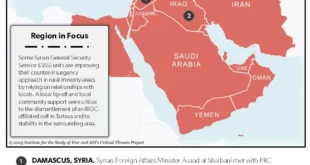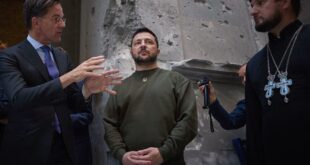How the West Can Still Protect Kyiv
Russian President Vladimir Putin appears poised to launch a large-scale invasion of Ukraine. He has amassed troops near the border, spurned Western attempts at a diplomatic resolution, and most recently recognized the independence of the so-called Luhansk and Donetsk People’s Republics, with Russian troops and weapons entering the region soon after. U.S. President Joe Biden has called Russia’s move into the Donbas an “undeniable invasion,” and announced a set of sanctions on Russian financial institutions, sovereign debt, and individuals. These were interim steps; Biden warned that more sanctions will follow should Russia continue to escalate the crisis. Berlin has also halted the certification of the controversial Nord Stream 2 pipeline linking Russian natural gas to Germany, marking a major shift in its policy toward Russia and sounding a warning to Putin that his aggression is alienating the country, along with others in Europe.
The Kremlin is undoubtedly watching the U.S. and European responses closely, and Putin is likely contemplating a range of potential scenarios. Russia may still launch a large-scale invasion of Ukraine, as the Biden administration expects. Or, since the United States and Europe have now announced new sanctions and are threatening more, Putin may choose a different strategy: the long grind. In this scenario, he would seek to consolidate control over Ukraine without triggering more severe punishment from the United States and Europe. He would work to weaken Ukraine’s sovereignty by squeezing its economy, launching crippling cyberattacks, and inciting coup attempts to undermine the country’s political system.
Putin may find this approach attractive because he believes that time is on his side. He may anticipate that Washington will eventually tire of confrontation, accept the status quo, and shift its focus to containing China. He may also assume that support for Ukraine in Europe will wane as gas prices go up and Ukrainian refugees flood European borders. To his thinking, economic pain combined with fear of war—deeply rooted among the German public, in particular—will eventually lead Berlin toward making concessions. In Ukraine, President Volodymyr Zelensky is under immense pressure and faces a bid for reelection in 2024. If the Ukrainian economy is floundering and the public grows weary of the constant threat of war, it could set the stage for a pliant leader who is friendlier to Russian interests.
So far, Washington’s savvy diplomacy has resulted in an impressive united front among the United States and its allies, and the collective strategy of coordinated and escalatory sanctions may yet deter an all-out Russian military takeover of Ukraine. If this approach succeeds, the United States and its allies will be rewarded with a long, twilight struggle both for Ukraine’s freedom and against Putin’s aggression more broadly. By now, it should be clear that as long as Putin is in charge, there will be no going back to a stable and predictable Russia or international order. If the transatlantic allies don’t want to be caught on the back foot, as they were in 2014, they need to prepare for now for a long grind.
LESSONS LEARNED
The United States and its allies should first aim to craft a long-term policy toward Russia that is clear-eyed about Putin’s aspirations. To do so, they must look closely at the lessons learned since the collapse of the Soviet Union in 1991. Contrary to the Kremlin’s narrative of grievance, the United States did not inflict a punitive or vindictive victors’ justice over post-Soviet Russia. The West did not demand reparations from the Russian state, as it did with Germany after World War I. To the contrary, the West provided Russia with emergency assistance and proposed longer-term support for general reform. It offered Russia a place in the Euro-Atlantic community and an “alliance with the NATO alliance,” as the Clinton administration put it.
President George W. Bush continued that approach and sought to strengthen Washington’s strategic partnership with Russia, especially after the 9/11 terrorist attacks. But neither Clinton nor Bush attempted to buy that partnership by allowing Putin strategic control over the old Soviet empire in Europe, especially after the victims of that empire had themselves overthrown communism and toppled the Iron Curtain. They refused, rightly, to perpetuate the line in Europe that Stalin drew in 1945. As the new democracies of central and eastern Europe ran toward Euro-Atlantic integration, the enlargement of both NATO and the EU offered the promise that a divided Europe was a thing of the past.
Putin believes that time is on his side.
The Bush administration maintained this policy even as Putin destroyed what existed of a nascent Russian democracy, changing course only after Russia invaded Georgia in 2008, marking what many at the time viewed as the end of an era of post-Soviet Russian cooperation with the West. Even in the wake of this landmark conflict, the Obama administration tried a reset with Russia, only to find that Putin’s repression at home and aggression abroad made it untenable. The Obama reset ended with Russia’s war in Ukraine in 2014.
Although President Donald Trump himself seemed to prefer Putin and his autocracy to Washington’s democratic allies in Europe, his administration did not and invested in securing NATO’s eastern flank, sending military assistance to Ukraine, and enacting new sanctions. The resulting policy incoherence of the Trump administration may have led Putin to conclude that the United States was withdrawing from its alliances, giving him a freer hand. After President Joe Biden took office, the administration saw China as the United States’ greatest challenge, and hoped to “park Russia” in a “stable and predictable” relationship. But as one senior National Security Council official put it privately, look where that has led the world today.
In short, successive U.S. administrations have reached out to Russia in the hopes of shoring up relations but have consistently met with frustration because Putin has no interest in having a productive relationship with the West—except on his own terms, with a free hand for repression at home and aggression against countries that he considers Russian territory. The West must deal with Putin as he is: a tyrant who murders opponents at home, wages wars of conquest, and has no real interest in Western-style diplomacy. As long as Putin rules Russia, it will be an adversary.
INVESTING IN THE FUTURE
The West must not give Putin the sphere of domination he demands in Europe. That starts with supporting Ukraine’s sovereignty over the long term and not merely as long as Putin threatens all-out war. A Russian sphere of influence over Ukraine, even without full-scale military occupation, would destabilize the country and the region: as understood by Putin, it would require the Ukrainian people to accept perpetual autocracy, no self-determination, and widespread corruption at home.
If Putin’s next phase of pressure on Ukraine includes economic coercion, the United States and Europe must help the former Soviet state strengthen its economic resilience. Contemporary Ukrainian society brings to mind that of Poland or the Baltic states just a generation ago: a citizenry eager for the better life that the rule of law and Europeanization can bring. To that end, the United States and Europe should incentivize Ukraine’s leaders to advance measures that bolster the free market and enforce the rule of law, including efforts to weed out corruption at all levels of government, institutionalize judicial reforms, and enforce transparency in public procurement processes.
As long as Putin rules Russia, it will be an adversary.
Europe must take the lead when it comes to investing in Ukraine’s economy. Germany has already suspended progress on the Nord Stream 2 pipeline and offered to help Ukraine achieve greater energy independence and integration with Europe. As the economic powerhouse of Europe and the largest provider of aid to Ukraine, Germany should rally European allies to invest in the sustainable development of Ukraine’s key economic sectors, such as agriculture. Ukraine also has a burgeoning technology sector with innovative companies in e-commerce, delivery, and finance. Europe, which is struggling to compete with the United States and China in technology innovation, should take advantage of the opportunities in Ukraine by establishing a technology investment fund to support partnerships between European and Ukrainian companies with governmental grants.
After the collapse of the Soviet Union, NATO membership was often seen as a path toward EU integration among the new democracies of central and eastern Europe. But since NATO membership does not appear to be on the near-term horizon for Kyiv, the model should be reversed: the EU should explore opening the door to Ukrainian membership. Europeans who are skeptical at the prospect would do well to remember that the antigovernment protests on Kyiv’s Maidan Nezalezhnosti (“Independence Square”) in 2013 began under EU flags. Since then, thousands of Ukrainians have paid with their lives for their desire to be part of the European community. At a time when Europe’s divisions threaten to undermine its security, Europeans should embrace Ukrainians’ commitment to European values and principles and their vision of a more united continent.
SPEAKING PUTIN’S LANGUAGE
Investing in Ukraine’s economic and social resilience will mitigate Putin’s economic pressure, but it won’t deter his military threats. As the journalist and historian Anne Applebaum has noted, Putin understands only the language of hard power. The United States and its allies, by acceding to Russia’s invasion of Ukraine in 2014, lost an opportunity to secure Ukraine’s ability to defend itself. Although Washington has provided more than $2.7 billion in security assistance to Ukraine and has increased support over the last year, this has not been enough to deter Russia. The United States and its NATO allies should step up their military support for Ukraine by continuing to provide weapons and training while there is still an independent Ukrainian state. That includes in the Black Sea, where Russia has militarized Crimea and now is asserting further control. Other NATO allies in the Black Sea area, most notably Romania and Turkey, must step up so that the United States does not have to bear the full burden of ensuring stability in the region.
Resistance also means challenging all forms of Putin’s aggression, whether in Europe or elsewhere. That means not just resisting Putin’s provocations against NATO’s eastern flank but also diminishing Moscow’s leverage over the West. This will require Western countries to reduce their dependence on Russian natural gas and raw materials such as titanium. The United States and Europe will also need to prevent Putin and his circle from parking their ill-gotten funds in the West’s financial system. The Biden administration rolled out a detailed anti-corruption package as part of its Summit for Democracy: it should apply those policies across the board, but especially when it comes to Russia.
The Biden administration and European leaders have prepared strong financial sanctions and export controls in the event that Putin launches a military assault on Ukraine. If Putin steps back from a full-scale military invasion but continues his aggression in other ways, the United States and Europe should decide which of these actions they will hold in reserve and which they will deploy in response to Russian hostility below the threshold of total war.
RETHINKING RUSSIA
As the United States learned during the Cold War, it can negotiate an adversarial relationship with another country. Even as it resists Putin’s aggression, Washington should offer strategic and conventional arms control, military transparency, risk reduction, and other measures in order to stabilize the relationship. Arms control can help shift a strategic competition from those areas of greatest danger to the United States and Europe, such as nuclear or conventional military stand-offs, to areas of greater opportunity such as long-term engagement with Russian society.
Putin’s actions do not necessarily reflect the inevitable culmination of Russian history. The United States and Europe should supplement a policy that deals with their current adversary in the Kremlin by investing in a better relationship with Russia down the road. That means providing Russians with information that circumvents the Kremlin propaganda machine; supporting Russian investigative journalists who seek to expose the lies and corruption within their own system; and bolstering the courageous, beleaguered members of Russian society—including those living in exile abroad—who seek a better future for themselves and their country than the one Putin that offers. Such outreach already exists. But it needs to be strengthened, especially as Putin’s repression intensifies.
The United States is long overdue to rethink its Russia strategy. Successive attempts to reframe relations have been tried and found wanting. Putin’s aggression has brought this on. Washington’s task is to see that Putin fails and that the West’s democratic alternative—based on a rules-based, liberal world order—prevails.
 Eurasia Press & News
Eurasia Press & News



